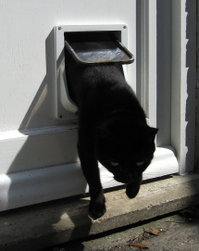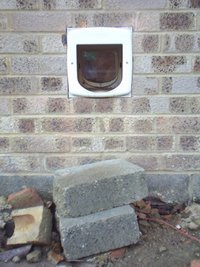

Custom Search
|
 A cat flap in action.
A cat flap in action.
A cat flap (also known as a doggie door or pet door) is a hinged flap set into a door, wall or window to allow cats, dogs, or other domestic pets to enter and exit a house on their own without needing a human to open the door. They are very popular with cat owners, many of whom like to encourage their cats' natural independence by letting them come and go at will particularly in the United Kingdom where it is believed that about 90% of all cats (including ferals) have access to the outdoors, many of these via cat flaps ([1]). Flaps for most dogs must be bigger and therefore are often constructed differently; except in rural areas they tend to give access to fenced-in yards or gardens rather than the neighborhood at large.
The simplest are just weighted flaps, but these can have problems with wind blowing open the flap or making a rattling noise. A magnet on the flap addresses this issue by holding the door in place when not in use, but not so securely as to prevent access. Sometimes a flap will also have adjustable catches to restrict the opening of the flap in one direction or the other for example to allow the animal to come in, but not go out again. More sophisticated flaps have electromagnetic catches that can detect a matching permanent magnet worn on the animal's collar and unlock the flap as the animal approaches, thus preventing any other animals using the flap to enter the house.
Devotees suggest a pet door should be set at a height so that the bottom of the opening is just a little lower than the belly of the animal when standing. Many animals prefer to use a flap with a transparent flap, so that they can be sure there is nothing threatening outside before leaving the safety of the home.
 A wall-mounted flap with access tunnel.
A wall-mounted flap with access tunnel.
The invention of the cat flap is often attributed to Sir Isaac Newton in the seventeenth century; this story, however, is usually related ([2], for example) without any sources to support it.
Cats, made by MultiMedia | Free content and software
This guide is licensed under the GNU Free Documentation License. It uses material from the Wikipedia.